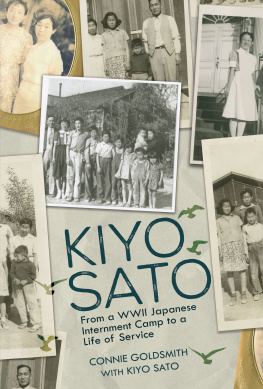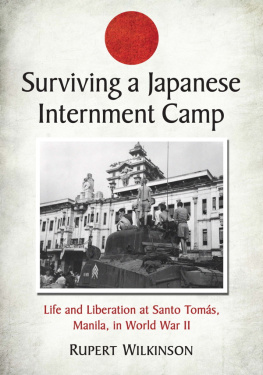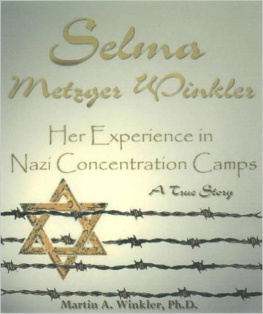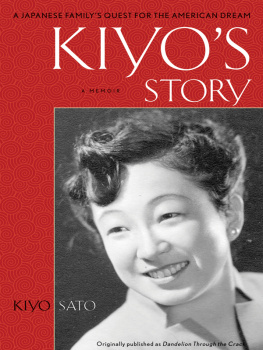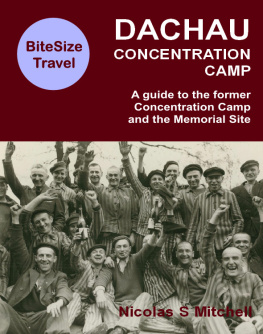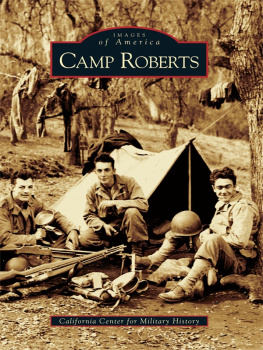I dedicate this book to all the Issei and Nisei who were unlawfully incarcerated during World War II and yet who still managed to live their lives with grace and tolerancefor the sake of the children. I also offer a grateful thank-you to Domenica Di Piazza, my longtime editor who helped bring so many of my books to fruition. CG
Young students are the people who will make a difference in our country. They are faced with so many challenges and bombarded with information, real and fake. In my lifetime, I have been taught many erroneous historical facts. Remember, the decisions you make will not only determine your future but the future of America. KS
Text copyright 2021 by Connie Goldsmith
All rights reserved. International copyright secured. No part of this book may be reproduced, stored in a retrieval system, or transmitted in any form or by any meanselectronic, mechanical, photocopying, recording, or otherwisewithout the prior written permission of Lerner Publishing Group, Inc., except for the inclusion of brief quotations in an acknowledged review .
Twenty-First Century Books
An imprint of Lerner Publishing Group, Inc.
241 First Avenue North
Minneapolis, MN 55401 USA
For reading levels and more information, look up this title at www.lernerbooks.com .
Main body text set in Adobe Garamond Pro.
Typeface provided by Adobe Systems.
Library of Congress Cataloging-in-Publication Data
Names: Goldsmith, Connie, 1945 author.
Title: Kiyo Sat o : from a WWII Japanese internment camp to a life of service / Connie Goldsmith.
Other titles: From a WWII Japanese internment camp to a life of service
Description: Minneapoli s : Twenty-First Century Books, [2020 ] | Includes bibliographical references and index . | Audience: Ages 131 9 | Audience: Grades 1012 | Summary: This is the story of Kiyo Sato and her family and their experience in the U.S. Japanese Internment Camps during WWII. Provided by publisher.
Identifiers: LCCN 2019046594 (print ) | LCCN 2019046595 (ebook ) | ISBN 9781541559011 (library binding ) | ISBN 9781728401584 (ebook)
Subjects: LCSH: Sato, Kiyo, 1923-Juvenile literature . | Sat familyJuvenile literature . | Japanese AmericansCaliforniaSacramentoBiographyJuvenile literature . | Japanese AmericansEvacuation and relocation, 19421945Juvenile literature . | Poston Relocation Center (Ariz.)HistoryJuvenile literature . | World War, 19391945Concentration campsArizonaPostonJuvenile literature . | United States Air Force Nurse CorpsBiographyJuvenile literature . | NursesCaliforniaSacramentoBiographyJuvenile literature . | Sacramento (Calif.)BiographyJuvenile literature.
Classification: LCC D769.8.A6 G65 2020 (print ) | LCC D769.8.A6 (ebook ) | DDC 940.53/1779172092 [B]dc23
LC record available at https://lccn.loc.gov/2019046594
LC ebook record available at https://lccn.loc.gov/2019046595
Manufactured in the United States of America
1-46287-46271-12/26/2019
Contents
Foreword
A fter Japan bombed the US naval base at Pearl Harbor, Hawaii, in December 1941, the United States officially entered World War II (19391945). The US government sent people of Japanese ancestry who were living on the West Coast of the United States to incarceration camps. These people had committed no crimes. Our grandparents Shinji and Tomomi Sato were shipped to the barren camp at Poston, Arizona. They were Issei, a Japanese-language term for first-generation Japanese immigrants to the United States. Under US law, Issei were prohibited from becoming American citizens even though they had lived and worked in California for decades. Their children are Nisei, a Japanese-language term for second-generation Japanese people who were born in the United States and are therefore US citizens. Our grandparents and eight of their nine childrenKiyo, Sanji, Aizo, Kozo, Kazu, Naoshi, Tomoko, and Masashiwere held as prisoners at Poston. Their oldest son, Seiji, served in the US Army.
Details of the World War II internment of Japanese American families are becoming more widely known as a tragic yet significant part of American history. Our Auntie Kiyo has taken the responsibility of ensuring that we all learn the stories and lessons of our parents and grandparents time in the Poston internment camp. She describes the irony for Grandpa and Grandma to have a son serving in the army while their other children were considered the enemyincarcerated and stripped of the very freedoms Seiji was fighting for.
Still, their unwavering dedication to their faith and to their beloved United States of America is truly inspiring. Our parents rarely spoke of the hardships they went through during their internment, and we dont remember our grandparents ever sharing their experiences with us. Yet we third-generation Sansei know how they handled the uprooting of their lives. We understand the blatant discrimination our family faced. Even so, we also grew up hearing about the Issei organizing sports teams and social events, creating schools, promoting church activities, and growing food crops in the inhospitable Arizona desert. Most of all, we learned about the community spirit that is such a part of our lives today. The US government took away freedom, land, and businesses. But it could not strip the Japanese in America of their integrity or their drive to do what was right for their children and for their country.
Today, as the children and grandchildren of the Issei, we enjoy a life free from the worst of the discrimination our parents and grandparents endured during wartime. Lessons of the Issei and Nisei might have been forgotten if our Auntie Kiyo did not have the passion and dedication to use her talent in writing and speaking to educate us. But Auntie Kiyo did not stop there. She has given her life to sharing with as many students as possible the tragic consequences of using fear as the justification for incarcerating innocent people based on their country of origin. Auntie Kiyo is determined that this will never happen again to any group of people.
In her published memoir, Kiyos Story , Auntie Kiyo shared the lesson of the dandelion through the crack, a seemingly insignificant flower that can endure and survive in unexpected places. Her father taught her that we are like dandelion flowers, able to thrive and grow under the most difficult circumstances. The dandelion has another lesson. Its a flower of seeds, and each dandelion will let loose its seeds upon the wind. Auntie Kiyo took the seeds of her lifes stories and passed them on so that other new flowers might be encouraged to root and sprout and grow. As you read her story, you may find you bloom as well. You might even be inspired to share your own unique story, with the difficulty and beauty it may hold. Thats exactly what Auntie Kiyo would want for you.
Humbly and with gratitude for all who came before us, Jodi Sato-King, the eldest of the Sato cousins and daughter of Kozo (George), on behalf of all the Sansei of the Shinji and Tomomi Sato family
Dandelion, a Haiku
Tanpopo ya
Iku hi fumarete
Kyoh no hana
John Shinji Sato, as recited to his daughter Kiyo, ca. 1970
Dandelion
Youve been stepped uponfor how long?
Today you bloom!
Kiyo Sato, translation of Dandelion, a Haiku, 2019
The Last Night
We lost so much in those early days, such treasures we had to leave behind.
Kiyo Sato, 2018
O n her last night of freedom, nineteen-year-old Kiyo Sato looked around her familys house near Sacramento, California. On February 19, 1942, the US government had ordered that she and her familyand all other persons with one-sixteenth or more Japanese bloodmust leave the West Coast for isolated American prison camps for the duration of World War II.

